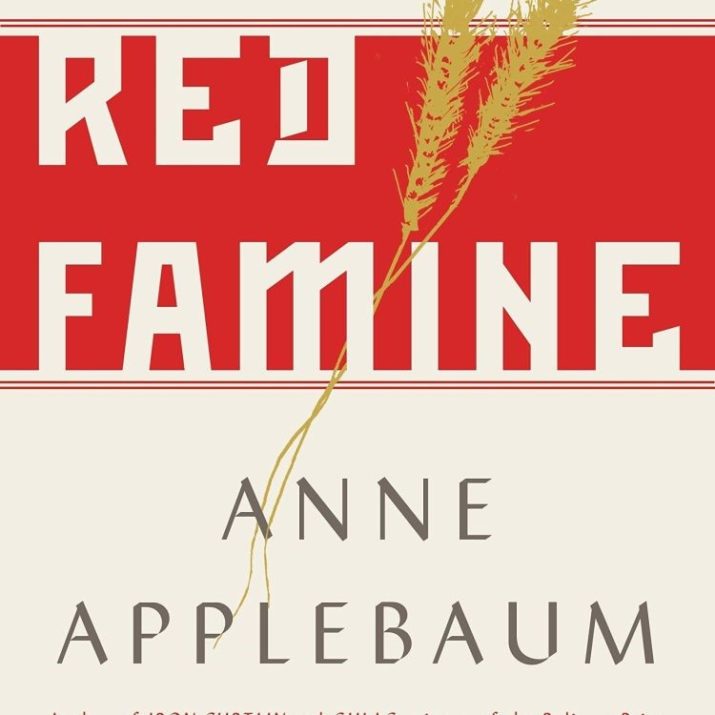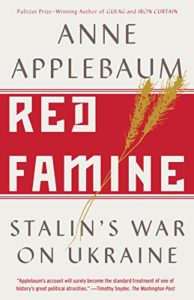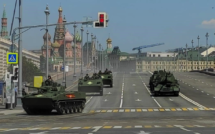

This is part of a series on the Ukraine Crisis.
Anne Applebaum’s Red Famine: Stalin’s War on Ukraine traces the Ukrainian nationalist movement’s unlikely survival through decades of escalating political violence, the famines of 1921-23 and 1928-29, the brutal de-kulakization and agricultural collectivization drives launched in 1930, and a mass famine in 1932-33 during which nearly four million Ukrainians died. While no corner of the USSR escaped turmoil and hardship in this era, Applebaum shows that under Soviet rule, the Ukrainian land and people were victims of singularly harsh measures that culminated in what Ukrainians then and now call the Holodomor, or “hunger extermination.” Applebaum’s primary aim is to uncover “what actually happened in Ukraine between the years 1917 and 1934” (xxv), and she uses an impressive array of archival sources to tell that story. She also explores Moscow’s ruthless and systematic cover-up of its crimes against Ukraine and its malign public disinformation offensives, as well as how ordinary Ukrainians and a handful of foreign journalists nonetheless managed to breach the enforced silence, and how Ukrainians have commemorated the Holodomor since independence in 1990.
In January 1918, Lenin’s panicked message to the Ukrainian front to “use all energy and all revolutionary measures to send grain, grain and more grain!!” (29), argues Applebaum, marked the start of an ever more vicious Soviet campaign to extract food from Ukrainian peasants to feed starving citizens in other regions and to export grain in exchange for coveted foreign currency. But this was not just about food: Applebaum documents the simultaneous push, first by Lenin and then by Stalin, to destroy Ukrainian material culture, music, religion, and language. Their goal was to eventually hasten rural Ukrainians’ deaths and settle loyal Russian-speaking peasants on the “empty” land (this was also the era when Russian workers surged into the eastern Ukrainian industrial province of Donetsk). Lenin’s view of Ukraine as a rich agricultural resource to be exploited for the benefit of Soviet Russia and the cruelties of the Great Grain Collection of 1920-21, Applebaum contends, laid the groundwork for Stalin’s subsequent—and more radical—casting of the Ukrainian people as lethal enemies within. Applebaum notes, too, that Moscow’s paranoia about Ukrainian nationalism’s potential to unravel the multi-ethnic patchwork of Soviet states had its roots in Tsarist Russia. Under Stalin, securing the territory’s agricultural bounty became an obsession embodied in the 1930 drive to deport or execute better-off peasants (kulaks) and forcibly collectivize Ukrainian farms. When these efforts met with widespread peasant resistance and a drastic decline in cultivation, the regime dispatched armies of searchers composed of students and workers to seize every scrap of food they could find. Searchers wielded specially made hooked metal rods that they used to pound and scratch on “ovens, beds, cradles, walls, trunks, chimneys, attics, roofs and cellars; to pry behind icons, in barrels, in hollow tree trunks, in doghouses, down wells and beneath piles of garbage. The men and women who used them stopped at nothing, even trawling through cemeteries, barns, empty houses and orchards” (265). Worse still, searchers were goaded by their superiors to degrade and torture the peasants they robbed. Survivors recalled how searchers threw lentils on the floor and jeered as children scrabbled to gather them, for example, or poured carbolic acid on salted fish, which the starving peasants ate anyway.
As historians of the Holocaust have stressed, the Nazis’ virulent dehumanization of their fellow citizens, first and foremost the Jews, but also the Sinti and Roma peoples, homosexuals, Slavs, and communists, was a necessary step toward the larger goal of their removal and, finally, total extermination. Applebaum observes that Raphael Lemkin, who first coined the term genocide in 1953, “spoke of Ukraine in this era as the ‘classic example’ of his concept: ‘It is a case of genocide, of destruction, not of individuals only, but of a culture and a nation’” (xxix-xxx, 413). Applebaum offers numerous instances of Moscow’s increasingly radical approach to solving the “problem” of Ukraine in comparison to the regime’s handling of peasant resistance and famine in other Soviet regions. One especially glaring example was the decree of 7 August 1932, which made the theft of food in Ukraine punishable by ten years in a labor camp or by execution: “Now, a peasant woman who stole a few grains of wheat from a collective farm would be treated like a military officer who had betrayed the country during wartime. The law had no precedent, even in the USSR” (216). Moreover, Applebaum contends that “The discovery of this vast political conspiracy provided an explanation: why the harvest was failing, why people were hungry, why the Soviet agricultural policy, so closely and intimately linked with Stalin, was failing” (253). According to this warped thinking, Ukraine posed an imminent and mortal threat to the Soviet Union, which is the same flimsy excuse recycled by Vladimir Putin to justify Russia’s unprovoked invasion of Ukraine in February 2022 and the heinous atrocities against its people in the past nine months, and which have continued daily.
One of Red Famine’s many strengths is Applebaum’s use of Ukrainian peasant voices to expose the horrors of these decades, many of them gleaned from collections of oral histories and local archives. Their brave testimonies pierce the dense cloak of official secrecy imposed in the months, years, and decades following the Holodomor. Applebaum uses the countless anguished pleas for assistance and the widespread reports of cannibalism that reached Stalin’s desk to make a compelling case that it was Stalin’s overriding objective to annihilate Ukraine. Chapters 8, 9, and 10, all titled “Famine Decisions” with different subtitles, underscore the intentional cruelty of the forced requisitions, the blacklisting of entire villages who failed to meet the required food quotas (and who were suspected of Ukrainian nationalist sympathies), the closing of borders to Ukrainian peasants desperately fleeing the impoverished countryside, the campaign to shift blame for the famine to the Ukrainian Communist Party, and the subsequent mass purge among Ukrainian officials. The Ukrainian secret police, first dubbed the Cheka, then known by the acronym OGPU (and today as the KGB), was instrumental in funneling evidence to Moscow of party members who refused to follow orders, such as one anonymous local official who opined in August 1932 that “To again force people to starve is criminal. For me it is better to turn in my Party card than to doom the collective farmers to starve through deceit” (218). Chapter 11, “Starvation: Spring and Summer 1933,” is filled with graphic and haunting accounts of survivors; one person remembered that his mother “looked like a glass jar… All her body that could be seen…was see-through and filled with water, like a plastic bag” (288). Corpse collection teams worked at night to hide the scale of the disaster and received bread in exchange for their labor. By spring and summer of 1933, cannibalism was pervasive. Even in Ukrainian cities, as reported by the Italian consul, “Children of party leaders and OGPU are especially targeted because they have better clothes than other children. Trade of human meat becomes more active” (307).
Applebaum describes the cycles of violence unleashed by Soviet authorities against Ukrainians and how lessons learned in the early 1920s were refined and amplified a decade later. Tasked with finding grain in southern Russia in 1918, “Stalin authorized arrests and beatings on a broad scale, followed by mass executions. Red Army thugs robbed local merchants and peasants of their grain; the Cheka then fabricated criminal cases against them—another harbinger of what was to come—and caught up random people in the sweep as well” (38). Stalin eventually renamed the city of Tsaritsyn, where most of the atrocities took place, Stalingrad. Applebaum also points to the first Bolshevik People’s Commissar for Food Collection, Ukrainian Alexander Shlikter; he would create in 1918 new “classes” of peasants and foment a lethal conflict among them. This version of “dividing and ruling”—and scapegoating—was central to the de-kulakization and collectivization campaigns at the end of the decade. As Applebaum notes, despite Shlikter’s failure to send anything close to the amount of grain Moscow demanded, his superiors clung to the harsh rhetoric and policies he devised. The massive peasant rebellion and famine that followed did not dissuade them either. However, Applebaum points to one striking difference in the regime’s handling of the famine in 1921 and the later tragedies: the new Bolshevik regime’s willingness to admit that hunger was widespread and to request western international aid, an openness that saved lives. This attitude contrasted sharply with the elaborate disinformation campaigns fabricated to explain Ukrainian suffering by the late 1920s, which became a pillar of Soviet governance thereafter—another insidious and deadly weapon also adopted by Putin.
Red Famine also documents the Holodomor’s long, chilling aftermath. Until Ukraine’s independence in 1990, citizens of the USSR, including Ukrainians, were forbidden to even allude to the famine of 1932-33. Some who broke the silence, for example the demographers who published accurate statistics for the 1937 census and showed a drop in population rather than the projected rise, were executed by Stalin. In contrast, the 1939 census was trumpeted as “a model piece of statistical research…[and with its publication] the great famine vanished not only from the newspapers but from Soviet demography, politics and bureaucracy” (360). Applebaum discusses the systematic destruction of other records of the tragedy, including those of medical professionals and local archives, and the willingness of Western diplomats, journalists (with a few heroic exceptions), and the Catholic Church to look the other way so as not to alienate the Soviet state. Applebaum argues that it was the 1986 nuclear disaster at Chernobyl that finally demolished the regime’s credibility at home and abroad, creating an opening for Ukrainian intellectuals and others to begin the agonizing confrontation with the Holodomor and with the decades of suffering and terror that preceded and followed it.
In her conclusion, Applebaum revisits the debates among scholars, legal experts, state officials, and the public about whether the Holodomor ought to be defined as a genocide. At the time of her writing, in 2017, she notes that the fierce partisan arguments of the 1990s over whether a genocide took place had faded somewhat. Instead, by the early 2000s, “the legal arguments about the famine and genocide were often proxies for arguments about… Ukraine’s right to exist… But now—after more than a quarter-century of independence, two street revolutions and a Russian invasion that was finally halted by a Ukrainian army—sovereignty is a fact, not a theory that requires historical justification, or indeed any justification at all” (424-5). Putin’s wanton destruction of Ukrainian lives and culture and his efforts to undermine Ukrainian sovereignty have recast these questions in ways unimaginable five years ago. Applebaum’s recent essay in The Atlantic, “Ukraine and the Words that Lead to Mass Murder. First Comes the Dehumanization, then the Killing” (April 25, 2022), uses evidence from Red Famine to explain the antipathy and disdain most Russians, and especially Putin, have for Ukraine and its people. She warns that Russia’s slick state-run media barrages the Russian public with the message that “The Ukrainians have no agency… they are not even human—they are ‘Nazis.’ And so, like the kulaks before them, they can be eliminated with no remorse.” For readers trying to understand the current war, Anne Applebaum’s deeply researched account of the Holodomor is an eloquent and wrenching testament to the ways in which dehumanization nearly destroyed Ukraine in the twentieth century and how treacherous the failure to confront past crimes against humanity is for the present and future survival of all sovereign democratic states. Red Famine underscores the urgency of NATO’s unified front against Russian barbarism that, at least so far, is still holding.
Elizabeth B. Jones is Professor Emerita of German and European history, Colorado State University. Her scholarship covers all aspects of rural Germany, with emphasis on the nineteenth and early twentieth centuries. She currently lives in Corvallis, Oregon and works with several community non-profits devoted to social and environmental justice and looks after a small forest.
Red Famine: Stalin’s War on Ukraine
By Anne Applebaum
Publisher: Anchor Books
Paperback / 544 pages / 2018
ISBN: 978-0804170888
Published on December 6, 2022




